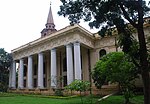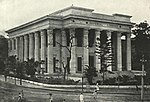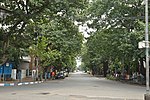The Bengal Presidency, officially the Presidency of Fort William and later Bengal Province, was a subdivision of the British Empire in India. At the height of its territorial jurisdiction, it covered large parts of what is now South Asia and Southeast Asia. Bengal proper covered the ethno-linguistic region of Bengal (present-day Bangladesh and the Indian state of West Bengal). Calcutta, the city which grew around Fort William, was the capital of the Bengal Presidency. For many years, the Governor of Bengal was concurrently the Viceroy of India and Calcutta was the de facto capital of India until 1911.
The Bengal Presidency emerged from trading posts established in Mughal Bengal during the reign of Emperor Jahangir in 1612. The East India Company (HEIC), a British monopoly with a Royal Charter, competed with other European companies to gain influence in Bengal. After the decisive overthrow of the Nawab of Bengal in 1757 and the Battle of Buxar in 1764, the HEIC expanded its control over much of the Indian subcontinent. This marked the beginning of Company rule in India, when the HEIC emerged as the most powerful military force in the subcontinent. The British Parliament gradually withdrew the monopoly of the HEIC. By the 1850s, the HEIC struggled with finances. After the Indian Mutiny of 1857, the British government assumed direct administration of India. The Bengal Presidency was re-organized. In the early 20th century, Bengal emerged as a hotbed of the Indian independence movement, as well as the epicenter of the Bengali Renaissance.
Bengal was the economic, cultural and educational hub of the British Raj. During the period of proto-industrialization, Bengal significantly contributed directly to the Industrial revolution in Britain, although it was soon overtaken by the Kingdom of Mysore ruled by Tipu Sultan as South Asia's dominant economic power. When Bengal was reorganized, Penang, Singapore and Malacca were separated into the Straits Settlements in 1867. British Burma became a province of India and a later a Crown Colony in itself. Western areas, including the Ceded and Conquered Provinces and The Punjab, were further reorganized. Northeastern areas became Colonial Assam. The Partition of British India in 1947 resulted in Bengal's division on religious grounds.









